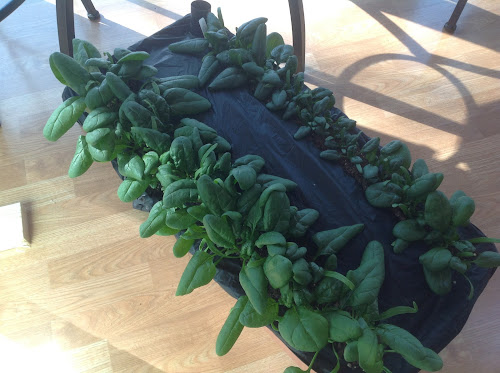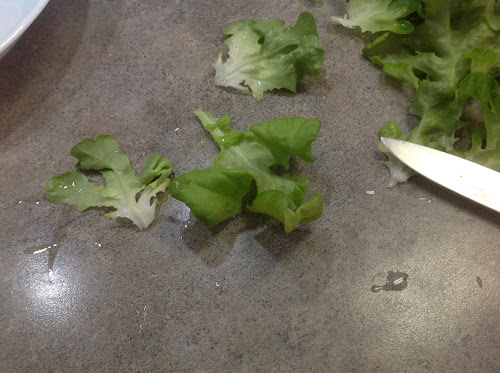This past Saturday afternoon, Mar 9, I was listening to someone proclaim that spring is here! He noted that after the rain how could it not be spring and that it was only a matter of a few days and the grass would start to green up. So Monday morning, Mar 10, I looked out our back windows to see how green the grass was becoming. Not very!
Even with nearly a foot of snow that we received this past weekend we still need to be planning and preparing for our 2013 garden. Hopefully you have a garden plan in mind and have selected and ordered any needed seeds. If not, there is time to order or stop at the local garden centers to see what is available. But don't wait too long as the best varieties go fast.
Many people believe they need to start the seeds in February or early March. I believe the biggest mistake people make when starting seeds like tomatoes and peppers is to start the seeds way too early. They end up with stunted plants or worse plants that have been infected by root rot and various "blights".
I have found that starting seeds in the first week of April produces plants that are at optimum for transplanting about May 16. Most years the weather after May 16 is safe to have plants out in the garden. By safe I mean free from frost and temperatures below 50F that last longer than 48 hours. These conditions can stunt a plant and cut summer production in half. Some years the weather doesn't cooperate and we have cold snap, so emergency covering for a night or so is needed.
So during the first week of April I will be start seeds for tomato, peppers, and eggplant. Rest of my garden is direct sowed. Because of our soil and trees I find it basically impossible to grow peppers of any kind, but always the optimist I am going to try again with a variety they is good for container gardening.
The size of the vegetable seedlings at transplant time affects the total yield of the plant. Best results are from relatively small, stocky plants that have only 5 to 7 leaves. As a rule, transplants of fruiting vegetables, such as tomatoes, peppers, and eggplant, that have not yet begun to flower, produce a greater yield and better quality fruit than would be obtained from larger, older transplants. The above chart can be used to find the best date to plant your seeds. More information on how to start garden transplants the tranditional way can be found in the Iowa State Extension publication Starting Garden Transplant at Home. In the future I will go into the method I use to start my seeds for transplants. Probably do this the week of April 1st when I start transplants.
Now for the progress on how the garden is growing. First I decided to grow some container tomatoes to see how early in the season I can have ripe tomatoes. I don't have much hope for success as the temperatures are too cool in the early spring and this is not good for tomato pollination. Anytime temperatures fall below 59F any tomato flowers will not set fruit. I selected two varieties of cherry tomatoes that are short season,excellent for containers, and are suppose to set fruit in cooler temperatures. The first variety is Patio Princess Hybrid. Here is a description and picture from the Burpee's catalog.
Perfectly sized, petite tomato plants for patio containers. Invite these petite plants onto your patio and get ready to enjoy a bountiful supply of the tastiest little tomatoes ever. The 2’ plants fruit mightily—producing as many 2½" fruits as plants twice their size. Patio Princess is just the right size for small pots and a large tub can fit 2-3 plants.
The second variety is Sweetheart Of The Patio. Below is a picture and description also from the Burpee's catalog .
Tolerant to Late Blight, an outstanding variety for containers and pots. This compact super producer has shown tolerance to Late Blight in numerous field trials. A sister line of the All-America Selections winning Lizzano, Burpee selected Sweetheart of the Patio for its superior yield and early fruit set. Bursting with snack-ready, supersweet baby cherries about 1" round, you'll have delicious, disease-free fruits the summer through. Plant it in a pot, hanging basket, or directly in your garden.
I planted 4 seeds of each variety in the AeroGarden that I use to start small numbers of transplants. I planted two seeds in each seed pod with the idea of thining to the strongest seedling. The reason for my planting strategy is that I want two plants of each variety as an Earthbox can accommodate four tomato plants of the cherry variety.
In the above picture you can see that tomato seedlings have emerged in three of the pods. The seeds in the front row far right did not germinate so I replanted and waiting to see what happens. The three pods in the center contain Salnova lettuce seed for plants to replace the lettuce we will soon be harvesting. Below is a close up of a seed pod that has been thinned to the best plant and a protective cover that controls moisture loss, algae and mold growth which could deadly to the seedling.
Below are some pictures of the spinach and lettuce crops so you can what has been happing with them.
Here the lettuce being prepared for a salad. This lettuce is a little less crunchy then romaine but not as wimpy as leaf lettuce. I have to say the lettuce has a good flavor.
That's all for this week more next week.













No comments:
Post a Comment